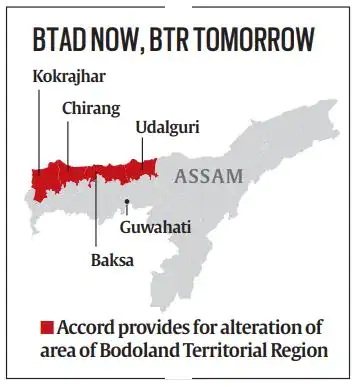Governance
Bodoland Statehood Movement
- 17 Oct 2020
- 5 min read
Why in News
A new organisation (All India Bodo People’s National League for Bodoland Statehood) has announced the revival of the Bodoland statehood movement ahead of the elections to the Bodoland Territorial Council (BTC).
Key Points
- About Bodos: These are the single largest community among the notified Scheduled Tribes in Assam. Part of the larger umbrella of Bodo-Kachari, the Bodos constitute about 5-6% of Assam’s population.
- About Bodo Statehood Movement:
- 1967-68: First organised demand for a Bodo state came under the banner of the political party Plains Tribals Council of Assam.
- 1986: The armed group Bodo Security Force arose, which subsequently renamed itself ‘National Democratic Front of Bodoland (NDFB)’, an organisation that is known to be involved in attacks, killings, and extortions. It later split into factions.
- 1987: All Bodo Students Union (ABSU) renewed the demand.
- A fallout of the Assam Movement (1979-85), whose culmination - the Assam Accord - addressed the demands of protection and safeguards for the “Assamese people”, leading the Bodos to launch a movement to protect their own identity.
- 1990s: Indian security forces launched extensive operations against the NDFB, causing the latter to flee to bordering Bhutan.
- In Bhutan, the group faced stiff counter-insurgency operations by the Indian Army and the Royal Bhutan Army in the early 2000s.
- Government Interventions:
- 1993 Bodo Accord: The ABSU-led movement from 1987 culminated in a 1993 Bodo Accord, which paved the way for a Bodoland Autonomous Council (BAC), but ABSU withdrew its agreement and renewed its demand for a separate state.
- 2003 Bodo Accord: In 2003, the second Bodo Accord was signed by the extremist group Bodo Liberation Tiger Force (BLTF), the Centre and the state. This led to the Bodoland Territorial Council (BTC).
- BTC is an autonomous body under the Sixth Schedule of the Constitution.
- The area under the jurisdiction of BTC was called the Bodo Territorial Autonomous District (BTAD).
- 2020 Accord: The Central government signed a tripartite agreement with the state government and different Bodo groups, including four factions of the National Democratic Front of Bodoland (NDFB), for a “permanent” solution to the Bodo issue. Some features:

- It provides for “alteration of area of BTAD” and “provisions for Bodos outside BTAD”
- The BTAD was renamed Bodoland Territorial Region (BTR).
- It provides for more legislative, executive, administrative and financial powers to BTC.
- Provision for rehabilitation of surrendered militants of NDFB and bringing a special development package of Rs. 1,500 crore for the region.
- Present Revival of the Bodoland Statehood Movement:
- According to the new organisation, the new (2020) accord has been a betrayal of the Bodo people. Besides being an inferior accord, it prescribes a reduction of the area currently under the BTC.
- The accord has a provision for excluding from the BTR villages with more than 50% non-Bodos and including villages with more than 50% Bodo people left out of the BTC map after the 2003 accord.
- According to the new organisation, the new (2020) accord has been a betrayal of the Bodo people. Besides being an inferior accord, it prescribes a reduction of the area currently under the BTC.
Way Forward
- The signatories of the accord will be under pressure to find a way out to ensure the successful implementation of the accord. Support of relevant organisations will be required.
- Further, the opposition to the latest accord voiced by organisations of non-Bodo communities, including Koch-Rajbangshis, Adivasis and religious and linguistic minorities, has given rise to fears that if their grievances are not addressed, the ethnic fault lines in Assam will deepen. Thus, the accord’s success will lie in the stakeholders working out a power-sharing arrangement in the BTR that privileges equity over hegemony.
- Peace will continue to be fragile in Assam’s Bodo heartland until an all-inclusive power sharing and governance model is evolved under the provisions of the Sixth Schedule.




